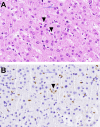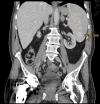Fever of Unknown Origin, a Vascular Event, and Immunosuppression in Tick-Endemic Areas: Think About Neoehrlichiosis
- PMID: 37476120
- PMCID: PMC10354681
- DOI: 10.7759/cureus.40617
Fever of Unknown Origin, a Vascular Event, and Immunosuppression in Tick-Endemic Areas: Think About Neoehrlichiosis
Abstract
Three patients were referred to our hospital because of fever of unknown origin (FUO) and thrombosis or thrombophlebitis. All of them had been under immunosuppression (IS) with rituximab. Intensive diagnostics for FUO and blood cultures remained negative. Finally, the association of fever, immunosuppression, and a vascular event led to the suspicion of Candidatus Neoehrlichia mikurensis (CNM) infection. The diagnosis was confirmed by species-specific polymerase chain reaction (PCR) in the peripheral blood. Therapy with doxycycline or rifampicin led to the resolution of the disease. A liver biopsy was performed in one patient due to hepatomegaly and elevated liver enzymes demonstrating hemophagocytosis. To our knowledge, this is the first histopathological study of liver tissue in CNM infection. The evidence of hemophagocytosis raises the question of whether symptomatic CNM infection might be in part related to host inflammatory and immune responses.
Keywords: candidatus neoehrlichia mikurensis; fever of unknown origin; hemophagocytosis; liver biopsy; rituximab.
Copyright © 2023, Margini et al.
Conflict of interest statement
The authors have declared that no competing interests exist.
Figures


References
-
- Candidatus Neoehrlichia mikurensis infection identified in 2 hematooncologic patients: benefit of molecular techniques for rare pathogen detection. Pekova S, Vydra J, Kabickova H, et al. Diagn Microbiol Infect Dis. 2011;69:266–270. - PubMed
Publication types
LinkOut - more resources
Full Text Sources
